
One of the important tasks of the child’s psychological development is the development of visual-spatial function. Its deficit is one of the most common causes of difficulties in mastering the curriculum. The visual-spatial function is what allows the child to assemble a house from a square and a triangle, find the left edge of the sheet, fold an airplane, navigate in a school building and many other things that we often find very simple, but for a small person they are serious and non-trivial tasks when he is just learning to do it.
For some children, mastering orientation on a plane, and then in space, causes more difficulties than others. For example, it is more difficult for lefties and girls, and for the same reason - because of the characteristics of interhemispheric interaction. When a woman says that she needs to turn left, bearing in mind that she needs to turn right, it’s just about the fact that she has a small deficit of visuospatial function. Because of this, many women find it difficult to read maps, and in order to understand which way to go, they first need to orient the map so that it matches the terrain. This, of course, does not apply to all women and is not evidence of a lack of mental abilities in general. Rather, it is a consequence of the fact that their hemisphere dominance is less pronounced. Another consequence of this is that girls develop more evenly, and boys are more prone to a certain specialization. Therefore, a round honors pupil is a role characteristic of girls rather, and the first mathematician of the class is more likely characteristic of boys. Accordingly, if we look into the math class, the girls there are expected to be inferior to the boys in mathematics proper, but they will better cope with writing essays. This, of course, is also a general trend, that is, a single boy can very well be a universal, and a single girl can be fully focused on a particular discipline.
In case of developmental disorders, the visual-spatial deficit can take quite crude forms. For example, we may find that an autistic child of six or seven years old cannot figure out which direction to turn to reach a well-known playground, and does not remember his place at the table.
For the diagnosis of visual-spatial function using the figures of Ray-Taylor and Ray-Osterrits. They look like this:
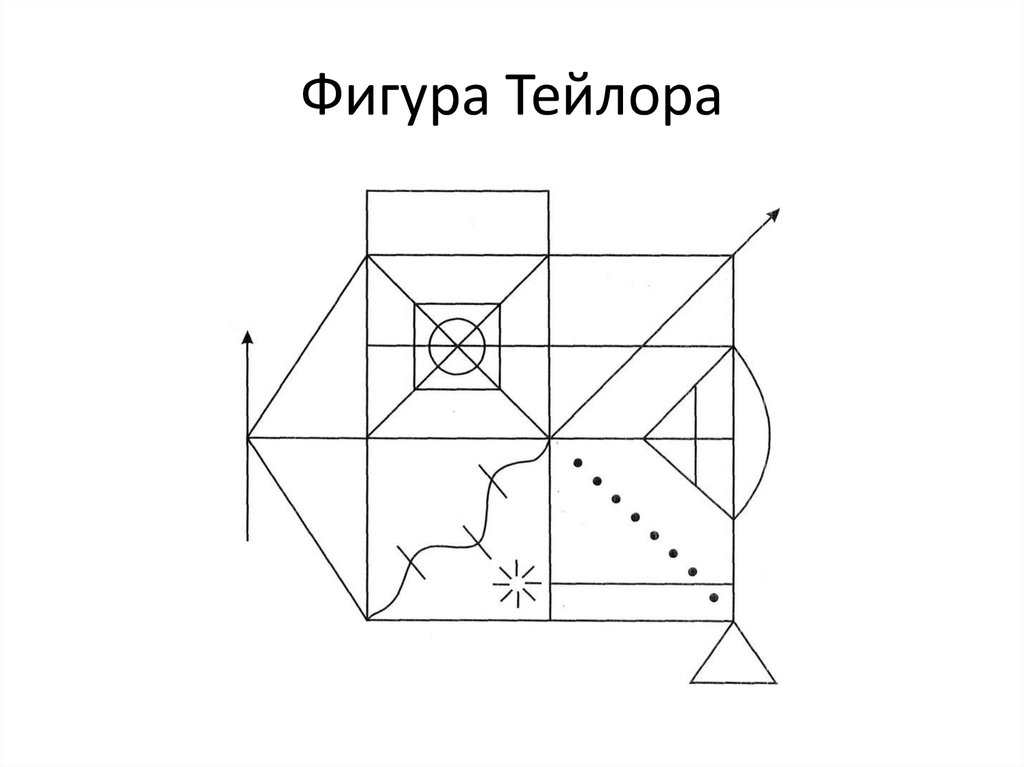
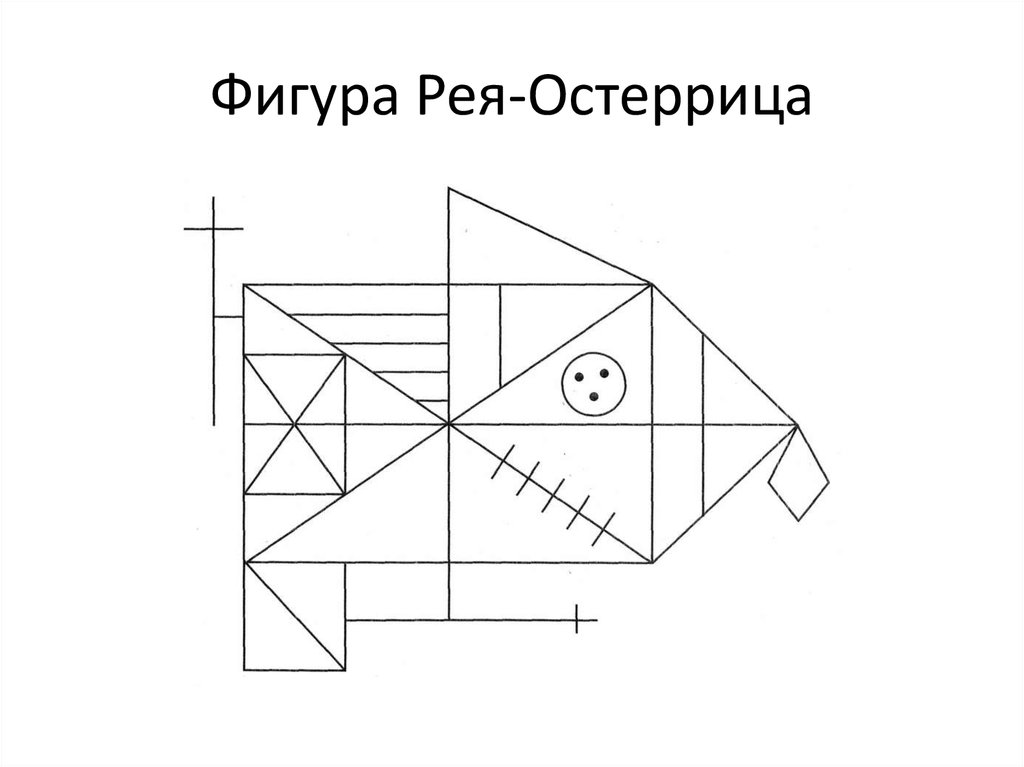
The child is instructed to copy the figure as accurately as possible without turning the sample. This test can be used from about five years old. Prior to this, it is uninformative, because the child does not have enough graphic skills for her. What will interest us here? Firstly, does the child have a complete image or does he reproduce a set of individual elements. Secondly, how accurately he reproduces the elements: doesn’t he lose them, does he not mirror if there are perseverations (when three bends of the wave turn into twenty, for example). Errors associated with increasing or decreasing the entire figure, as well as with distortion of proportions, are expected for preschoolers, and we may not pay much attention to them (a very small picture may indicate problems with self-esteem, but this is another story).
A Ray-Taylor figure can be presented to children as part of a school readiness diagnosis. As with other well-known diagnostic methods, there is a great temptation to teach a child to perform it correctly in order to show the best result. This temptation must be fought. The ability to reproduce the Ray-Taylor figure by heart does not relieve the child of difficulties with spatial perception, if any, and it is important for teachers to get accurate information about the child’s capabilities: when it is known that there are problems, then this can be taken into account and something to be done (for example , the child may be referred to a neuropsychologist). Accordingly, if any suspicions arise, then at home it is permissible to give the child a figure of Ray-Osterrits (it is used less often for diagnosis), but there is no need to tell how to copy it correctly so as not to blur the diagnostic results when it is carried out by a specialist.
The center of the universe is me
Before we can orient ourselves in the outer space, we need to orient ourselves in our own body, because it is precisely this that is our reference point. Behind - this is behind the back, to the left - this is from the side where the left hand is. While the child has not yet begun to walk, he solves the problem of the initial development of his own body: he gets acquainted with what parts it contains, learns to recognize signals from the body, and builds a body diagram. For the first year of life, the child still does not know everything about his body, but what he learns will be enough to begin to move in space.
If a child’s bodily sensitivity is disturbed for some reason, then his movement in space can be chaotic, we can notice that he stumbles on furniture, unsuccessfully fits into doorways. If we put such a child in the back of a toy under a T-shirt, he will not notice it, will not try to remove it. If we grab the heel so that he does not see, then he will not try to free himself. Such a child hardly interacts with space, because he does not feel himself in space, he does not have a reference point. With him you need to play infant games about body parts, do a lot of massage and passive gymnastics. For such children, bodily games are very good: for example, when dad grabbed tight, and you need to break out, twist. Or when a child is rolled up in a blanket and he crawls in this sausage, like a caterpillar.
A later effect associated with the body scheme is when a child who is not quite determined with a leading hand confuses the right and left. Usually we teach children to navigate through their hands. Which hand you eat is the right one (left-handed people have the left), and where the right hand is, there is the right side. If the child cannot confidently answer the question with which hand he takes the spoon, then the orientation falls apart. Difficulties in distinguishing between the right and left sides create problems in the development of writing: a typical mistake of six years is the mirroring of individual letters. With more pronounced difficulties, you can sometimes observe how the child mirrors the entire text: he writes not from left to right, but from right to left.
From the side of the game, we can do two things here: first, use games where the child needs to place chips or other components in front of him in a certain direction. For example, if we play mahjong with a child, we ask him to orient combinations of the “1-2-3” type (chow) strictly from left to right: a smaller number on the left and a larger number on the right.

If a child lays cards in front of him in a row, then we ask him to put his first card on the left side, and the rest after it. This helps to form a motor stereotype of movement from left to right, which will then support writing. Accordingly, the second thing is a visual label. Before the start of the game, we can put on the child’s right hand a cute bracelet, an elastic band for hair or a bright ribbon, so that it is easier for him to use the body as a guide. After a while, he will remember where the mark is usually located (both at the level of visual and bodily sensations), and it will no longer be needed.
Thinking with hands
The first stage in the development of thinking is visual-effective thinking. In everyday life, we use it, for example, when we need to put several large things in a small bag, and we fit them to each other in such a way until they all fit (or we come to the conclusion that the problem is unsolvable). In a child, the rapid development of visual-effective thinking occurs from one to three years. At this time, his leading activity is a manipulative game. He learns the properties of objects and their behavior in dynamics: what rolls and what only glides, what falls, and what crumbles, and so on. Then, of course, he will improve in this direction, but other tasks will come to the fore. And now this is the most important thing for him - to understand how to interact with objects.
The characteristic toys of this period are the Segen sorter and board. A typical sorter is a box with holes of different shapes, where objects of the same shape are inserted (usually geometric primitives such as cylinders and prisms), and the classic Segen board is a plate with inserts in the form of geometric shapes. In practice, similar boards with thematic inserts are more often used: for example, animals, tools, fish, cars. With both types of toys, the child solves the same problem: he needs to place the liner above the hole and turn it very precisely so that it coincides with this hole and can pass into it. At the stage of visual-effective thinking, this problem is solved by trial and error: the child twists the element with his hands until it coincides with the hole. Later, relying on this experience, he will switch to visual-figurative thinking: manipulations will go to the inner plane and the child will already be able to imagine the correct position of the element in order to immediately turn it as it should. In adulthood, well-developed visual-figurative thinking just allows you to mentally rotate the map in order to understand which direction to go.
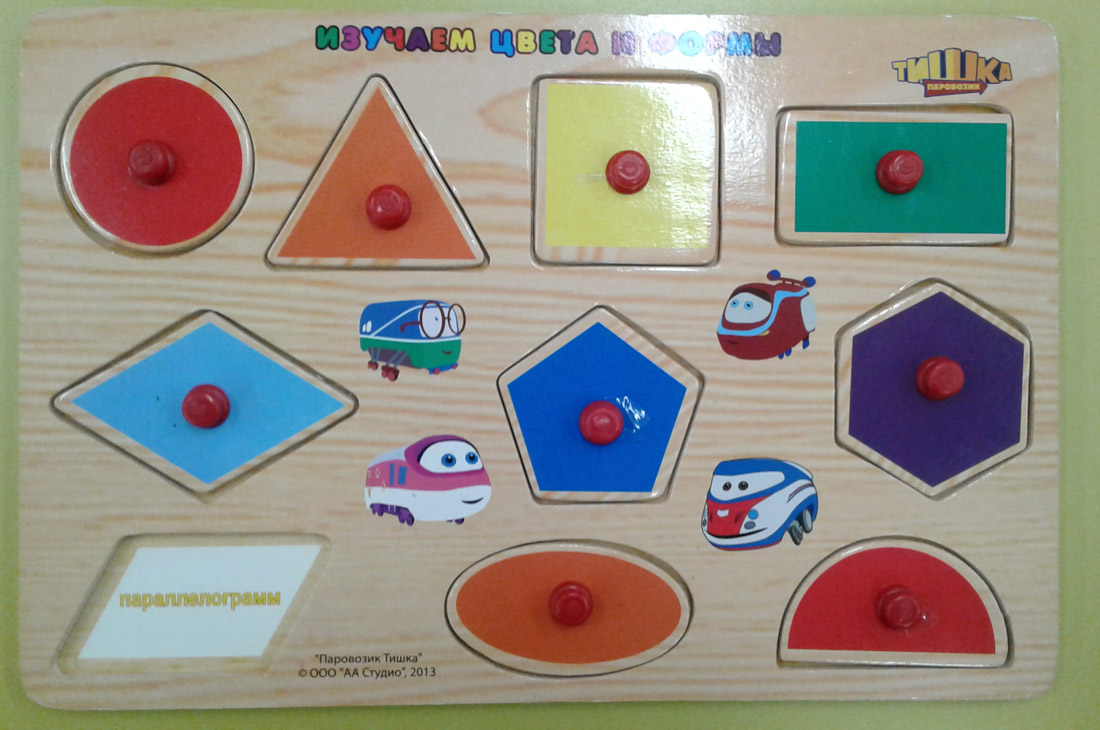
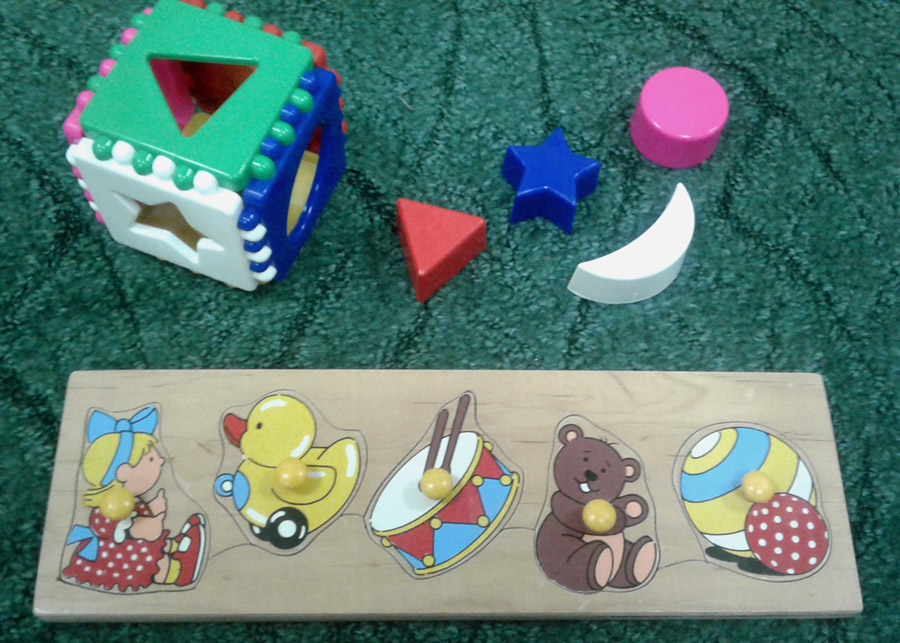
The development of thinking is not a very stepwise process. That is, we can trace the clear connection between the development of visual-effective and visual-figurative thinking, but verbal-logical thinking, for example, develops quite independently of the first two types. In practice, you can often see children who reason very well, but find themselves helpless when they need to do something with their hands. On the other hand, there are people without strong rational thinking, but with very developed “manual intellect”, and from these wonderful masters are made - joiners, potters, jewelers. Developed visual-figurative thinking is important for artists and designers - it, in particular, allows you to mentally make changes to the composition and approximately evaluate how successful they will be. That is, there is space for individual differences, inclinations and preferences. Considering a single child and analyzing his capabilities, we ask the question whether different types of thinking are enough for him to solve typical everyday and educational problems. It is clear that we will not expect compositionally perfect drawings from a child who is clearly oriented towards textual modality, but we would like him to be able to solve typical geometry problems. We will not expect engineering work from him, if this is obviously not his hobby, but it is desirable that he could tie his shoelaces to himself. The logic is something like this.
Stick, stick, cucumber
For preschool age - the next age stage - a symbolic game is characteristic. Manipulation is becoming a technical, secondary part of the game, and the plot comes to the fore. It’s fun to drive a car at three years old and at five years old, but at three years old the child gets a buzz from the very fact that the car is rolling, and at five years old - because criminals escaping from the police (or the police, catching up with criminals).
At the stage of preschool childhood, a child is not interested in solving an abstract problem, for which there is no history or image. Accordingly, we begin to build on images. The development of visual-spatial function in a preschooler largely occurs through visual and constructive activity. He masters visual analysis and visual synthesis - he learns to distinguish simple forms in complex objects and, on the other hand, to perceive a composition from simple forms as a specific object.
Here, too, representation follows manipulative experience. First, we give the image in modeling, applique or mosaic, then in the drawing. First, the child picks up the ready-made shapes of a square and a triangle, draws them together and receives a house, and then, when he knows both these shapes and their combination, he can draw the same thing on a piece of paper. You can, of course, start right away with free drawing, but then we are very likely to encounter the fact that the shapes in the drawing will be blurry, vague: instead of a square, a potato, instead of a triangle, a pointed potato. You can use stencils to help your child with the development of forms. Sufficiently thick mosaic elements, for example, can be put on a sheet and outlined with a pencil.
Mosaic is a very characteristic toy of preschool age. When choosing a mosaic, we should first of all be interested in two things: the shape of the parts and the system of their fastening. Mosaics, in which all the elements are of the same shape (round or hexagonal), are not very good for the development of the visual-spatial function, because they do not require solving the problem of turning the figure. But if such elements are attached to the base board with pins, then the mosaic will be nice to develop fine motor skills (it’s also necessary to get into a small hole with a small stick).
Actually for the visuospatial function, it is preferable that the mosaic elements are squares, triangles, and sectors of the circle (or whole circles). If they are not fastened at all, but simply laid out (as in Fröbel’s gifts), the child is free to compose them into an image — the grid does not limit him — but he needs a fine coordination of movements so as not to displace already laid out parts. Sweeping and impulsive children, this can be annoying.
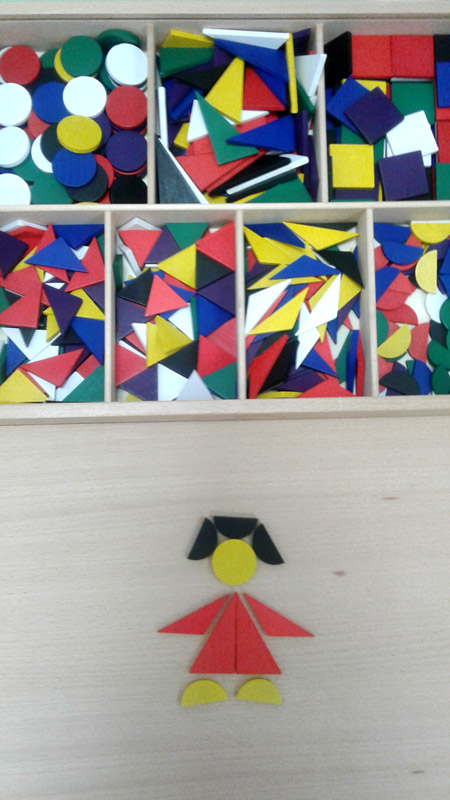
If the parts are mounted on magnets, this allows the child to work in a vertical plane. When we work on a table, we need to convert the vertical plane to horizontal, changing the coordinate system. What was higher, we have further, and what is lower is closer. Accordingly, we call the edge of the sheet farthest from us the upper, and the nearest lower, although formally they are at the same height from the floor. In experience, we were given a vertical tree, but when we draw, we place its image in a horizontal plane. Sometimes this operation of transferring from one plane to another can cause difficulties for the child. In particular, some children with developmental disabilities cannot use as an example what the teacher depicts on the board because the board is vertical and the table is horizontal. If they work on the table, then they need the sample to also lie on the table in the form of a separate task sheet. Very young children may experience similar difficulties, and for them a vertical plane (easel, magnetic board) may be more convenient.

A game related to mosaics is Koos cubes, a variant of which is found under the name “Fold the pattern” as part of the Nikitin materials. Koos cubes are actively used not only in teaching preschoolers, but also in the clinic of local brain lesions for rehabilitation after surgery. Each of the six faces of the cubes is colored in its own way, but although the cubes themselves are spatial objects, the problems here are still solved planar - you need to lay out the same picture from the cubes as on the sample. It is amusing here that a rotation of the sample by forty-five degrees sharply increases the level of complexity, and a picture of four segments oriented like a rhombus is often more difficult for a child than a picture of nine segments in the usual orientation.
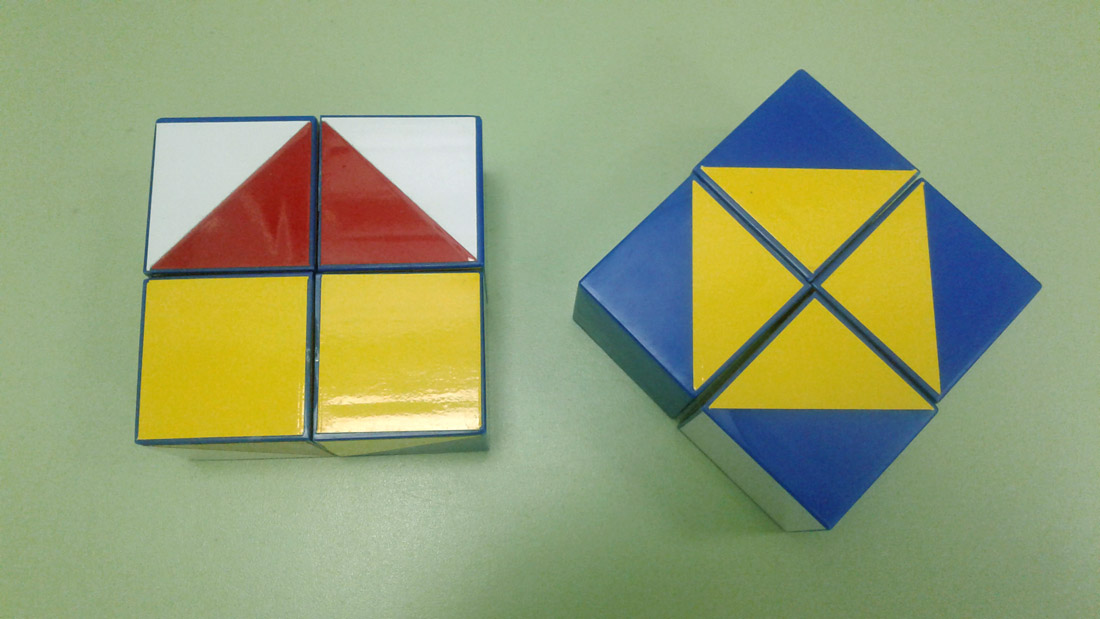
The checkered structure of vertical and horizontal lines is familiar to us - these are notebooks, panel houses, and cabinets with shelves. We encounter her at every step. The structure "in a rhombus" we observe much less often, and it needs a separate habit. The hexagonal structure is even more complex; Before games with a hexagonal field, some children ripen by the age of six to seven, but in general they become available already at school age.
Add the third coordinate
In parallel with the development of the ability to act on a plane, the ability to operate with spatial objects develops. When a child moves from doodles to subject drawings in which a specific image can be distinguished, in construction he also moves from pointless compositions to models of specific objects. Accordingly, all kinds of designers become relevant.
About three years old, it is often more convenient for children to deal not with the designers themselves, but with cubes, which generally do not attach to each other, or are attached to magnets. For more complex systems for connecting parts at this time, motor skills may still be lacking, and they will interfere with construction more than support it. In the future, designers also need to be selected so that the parts are attached to each other easily, reliably and safely for the child. For example, Zoob designers are not suitable for preschoolers at all - too much force must be applied to the details, and you can easily pinch your finger. Magnetic ball-wand constructors can be used with a six-year-old child under the supervision of an adult (so as not to eat the parts), but the panels from such constructors become available only in elementary school, and even then not for all children - coordination of movements is too fine.
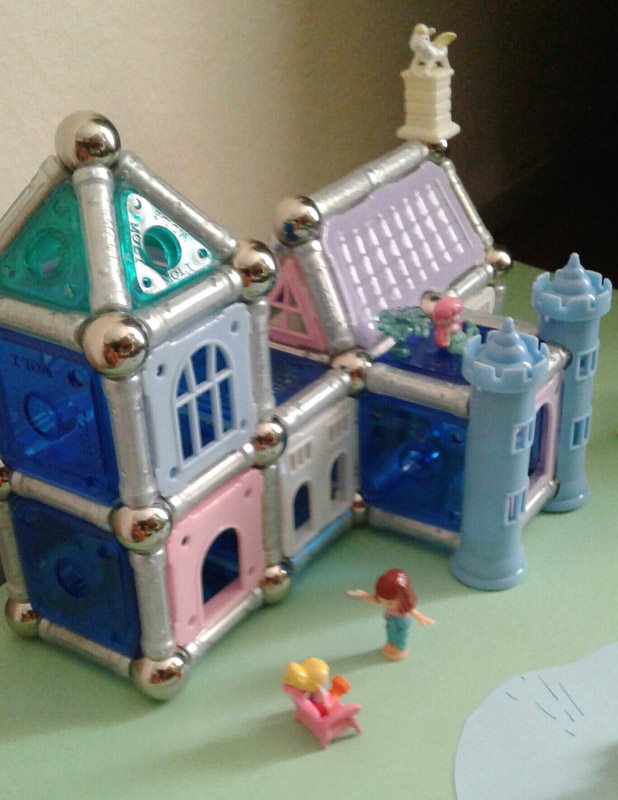
Designers like Magformers are actually good from the age of five, because the buildings from them are not very stable and, when moved incorrectly, fold like a house of cards, which makes it difficult for children of primary preschool age to build. In three or four years, they can be given plane tasks (lay a path, a snake, a panel house) or make towers, stacking parts in piles.
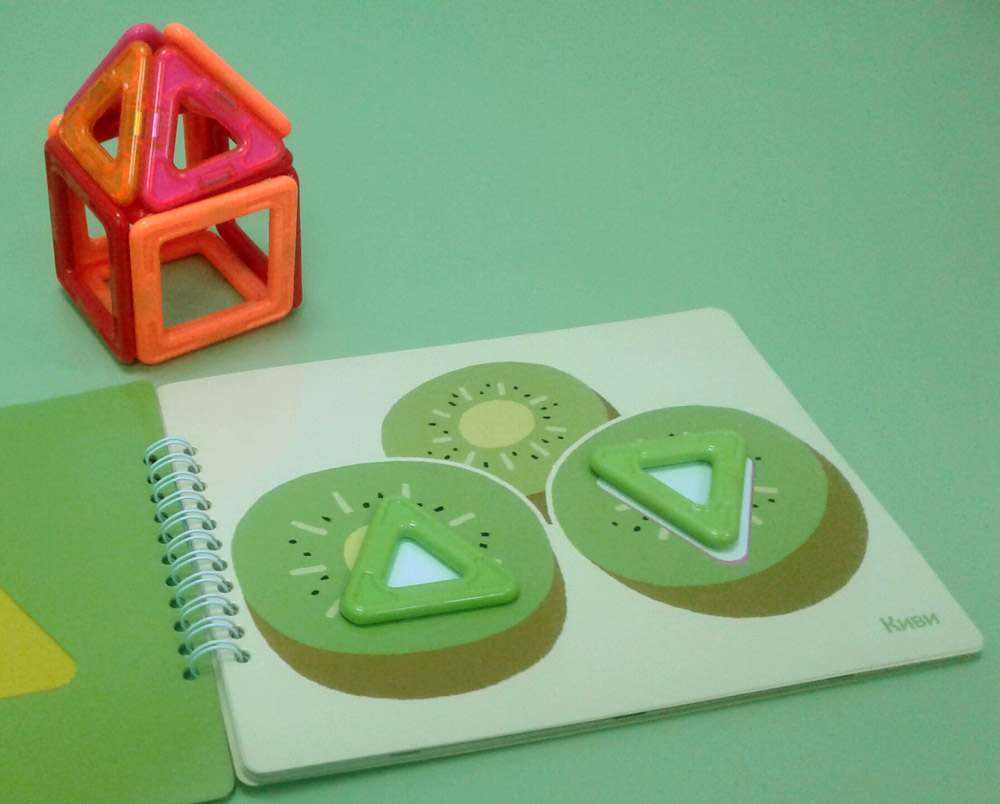
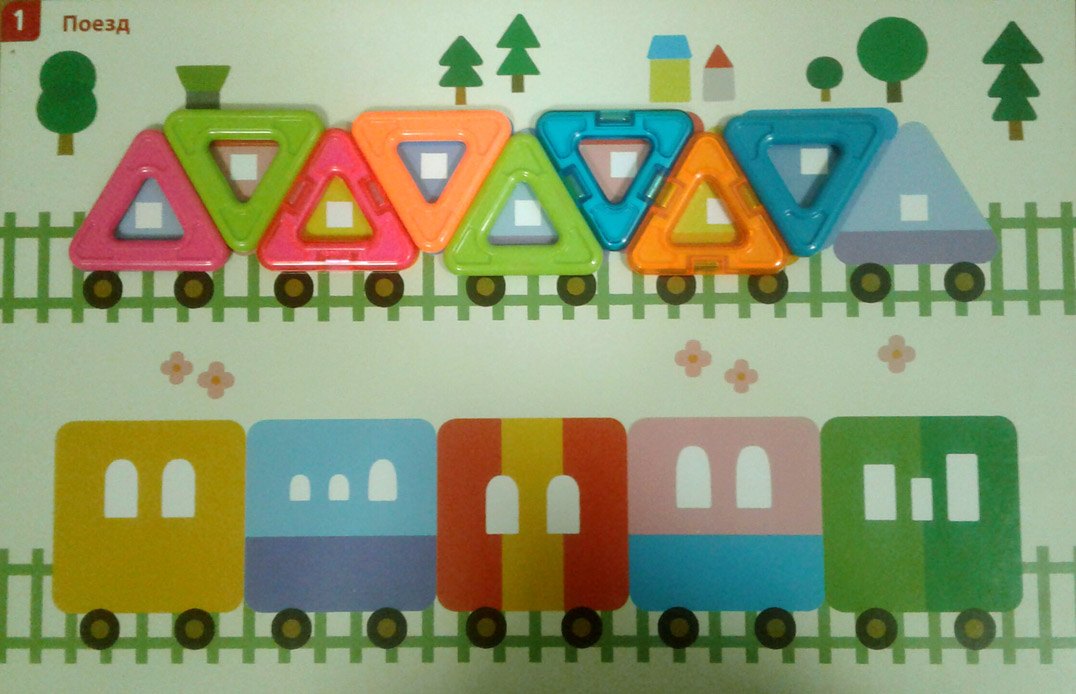
Now for Lego. At three years old, Lego's standard parts are still too small for most children (Duplo is more suitable for three-year-olds), and then depending on the child’s inclinations and his motor skills. Someone is ready for the transition from Duplo to standard parts in four years, someone in six. At an average of five years, standard parts are already available. At six years old, micronets with a couple of dozen very small elements go very well in children. Children collect micro-compositions from them (laser gun, ice cream, etc.), and this is an excellent exercise for fine motor skills. Large kits, from which a complex car, plane or something else is assembled, have the disadvantage that when a child himself or with the help of his parents copes with assembling the model according to the scheme, he feels that he has a cool toy. But he understands that if you take it apart, he will lose a cool toy, and he won’t be able to do anything even remotely so cool from these same details (model designs significantly exceed the level of complexity of what is available to the child in free construction). Therefore, in order to relive the joy of construction, the child needs some other box with a different model, and in this place some children quickly form an addiction to the Lego designers. To prevent this from happening, with preschoolers it is better to use not kits for assembling a specific model, but kits with a large number of standard parts, which the child can use at his discretion.

Constructors of the Lego type (MegaBlocks, etc.), the main detail of which is a cube or brick with protrusions and indentations, develop visual-spatial function only at the initial stage of development, when the child gets used to acting in a space divided into conditional cubes. This is the same structure of space that he later encounters in mathematics and physics in school as a three-coordinate system. The skill of playing with one such constructor is easily transferred to all the others of the same type. As soon as the child becomes comfortable with the space segmented into cubes, the designer then solves other tasks, primarily the development of fine motor skills and communication skills (if the child does not play alone). Own constructions of preschoolers from such designers are most often quite stereotyped - these are either houses, or cars, or their combination: houses on wheels and parking lots (houses for cars). Creativity is usually manifested in the decoration: furniture in houses, decorative details of cars, etc.
At the household level, the urban space surrounding us is basically structured specifically into cubes. Premises in houses are parallelepipeds, exactly composed with each other and constant in height, the streets for the most part are connected at right angles to each other, the walls of the houses are parallel to the streets. This is a fairly homogeneous space, it is predictable and easy to navigate in it. But what happens when a person adapted to such a space gets into another, curvilinear? The interiors of Waldorf schools, for example, are purposefully organized in such a way as to avoid straight lines and right angles. Accustomed to cubes, a person can experience sharp disorientation in them, losing access to the coordinate system. The space of natural objects, in the image and likeness of which Waldorf interiors are created, is also curved, and the cubes are not prepared for orientation in such a space.

The first obvious idea here is that in order to interact well with a space of a certain type, you need to interact with a space of this type. In particular, to navigate well in the forest, you need to walk a lot in the forest.If we talk about computer games, the first-person view gives an experience that is close enough to the real experience of moving in an unfamiliar space. First-person shooters, for example, practice orienting skills in an unfamiliar place, both based on the plan and without it (depending on whether the minimap is available and whether it is turned on). Games for such purposes are very good, because getting the same amount of experience of independent walks through unfamiliar buildings and streets in real life is both difficult and unsafe for a child.
The second point is that it would still be nice to bring the experience of not rigidly structured and not quite straightforward space into children's design. And for this, the designers are just very good, from whom it will not be possible to make either a house or a typewriter, but something else will turn out, maybe strange and Martian. In this sense, bending parts, the ability to connect parts at arbitrary angles, and non-standard fastening methods are very valuable.

Designers of this type are developing just for the visuospatial function, because they push the child to operate in a non-standard organized space. It is non-trivial and sensitive to the brain. The Lego addicts on this site say: “No, I’d rather play Lego,” not because Lego is more useful to them, but because it’s familiar, predictable and doesn’t make creaks meander so much. Probably, the attractiveness of the Minecraft game for children is at least partially connected with the familiar and well-developed space of cubes, the activity in which they have been brought to automatism.
Unfortunately, the more the activity is automated, the less its developing potential becomes. And the fact that it has great developmental potential requires appropriate mental efforts, which for a child will inevitably be tiring. The meaning of the game as an instrument of development, in fact, is to balance this tiresomeness with positive emotions. If the game materials do not cause enough positive emotions (they are uninteresting, ugly, uncomfortable, etc.), then the game does not work as a game, but works as an activity - that is, the child quickly loses interest and does not return to it on his own initiative. Therefore, on the one hand, developing potential is important to us, and on the other, attractiveness, because the first will not work without the second (or will, but for a very short time).
Cartography
One of the important skills of mastering space is the ability to compare space and its plan. On the one hand, having a plan can greatly facilitate orientation in unfamiliar areas; on the other hand, learning to read diagrams is a separate non-trivial task. Preschoolers mature to this by about six years old. First, we draw with the child a plan of a familiar room - for example, his room or class. Being in the room, the child examines it from the point of view of spatial relations: on which wall is the window, on which door, what is to the left of the door, what is right, what is in the corner - and reflects what he saw on the diagram. In the same way, you can draw a plan of the playground. With schoolchildren, you can depict the neighborhood of the house - the nearest streets, neighboring houses, kiosks, overpasses.

When the child understands how the floor plans are arranged, you can teach him to use the information reflected on the plan. For example, you can hide several toys in different places of the apartment, mark these places on the plan of the apartment with crosses and suggest that the child use the plan to find all the “treasures”.
A related task (usually more complex) is the correlation of space with a verbal description. If it’s difficult for a person to correlate space and text, then even if he has enough social skills to ask for directions on the street, instructions like “get to the corner, turn right and go to the next street” will help him little. If we correlate the terrain and the plan, then in any case we act within the framework of one modality - visual. And for orientation according to the verbal description, it is necessary to transcode information from one modality to another, which for most people will require the friendly work of two hemispheres: the right hemisphere is mainly engaged in processing visual information, and the information component of speech is a specialization of the left, not only right-handed people, but and most lefties.
Preschoolers at the level of orientation in space according to the description can be derived, for example, through origami. The first level of complexity, the simplest, is when we collect the figure at the same time as the child and at each stage we show him on our same piece of paper what exactly needs to be done and what should happen (while describing all the actions in words). At the second level of complexity, when the basic operations are learned and the child understands the meaning of each individual word, we begin to move from a direct demonstration to a diagram, depicting on a blackboard or on a piece of paper that the child sees in front of himself where the fold line will go and what should result . And we also accompany this with a verbal description. After a while, the child gets enough verbal instructions like “the fold line will go from an acute angle to the middle of the opposite side,you need to bend back ”, and he can do without visual support. Most six-year-olds reach this level in a year.
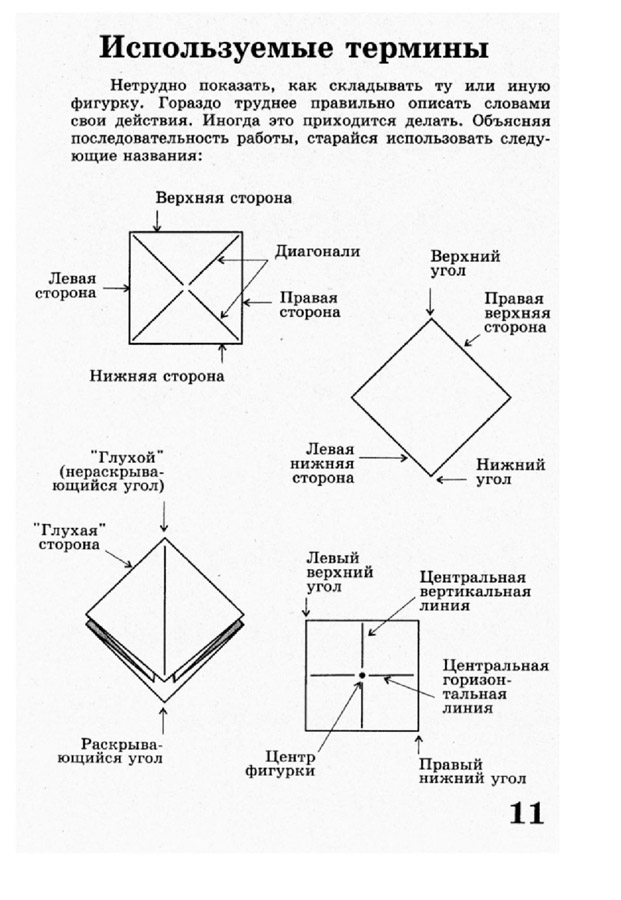
You can approach this from the other side - using role-playing systems like Dungeons & Dragons. The easiest option for perception is when both the miniatures are voluminous and the location is also voluminous: with vertical walls on which you can directly see windows and doors, etc. If the elements of the environment are made with a high degree of realism, then this provides the maximum effect of immersion - precisely due to the fact that the player requires minimal mental effort to navigate in space. In fact, he can only make an adjustment for scale. As we understand, this same option will be the least developing. But we can use it to facilitate the transition to more complex options, describing the room for the players as if they did not see it: “This is a square room. In the middle of the wall opposite the entrance you see a fireplace.In the far right corner is a bookcase. ”
The next option, a little more difficult to understand, is tile systems. Here the player needs to imagine the space of the room based on its flat projection. Windows, for example, can no longer be viewed directly, they must be read from the plan according to a schematic image. But the figures here are still voluminous, they are about the same scale as the tiles, and the player can easily estimate the size of individual rooms. Normally developing preschoolers, this option is quite accessible to six years. Here we again describe the room, as if the players had not seen it in order to establish a correspondence between the image and the words.

An even more difficult situation for players is when they have only a schematic floor plan, where nothing is indicated except for doors and windows. If it is made on a small scale, then there you can’t especially rearrange the figures. Players receive all information about the space, except the most basic, from the words of the host. Some visual support is still preserved here, but just as a support, the imagination takes on the main work.

The most difficult option, which in modern D&D is almost uncommon, but was actively used in early versions of the system, is to not give the players a map at all, but to allow them to independently map the location according to the leader’s description. Players receive a sheet of paper in a box, and the presenter says a text like this: “After passing through the portal, you find yourself in a corridor three meters wide and fifteen meters long. A door is visible at the opposite end of the corridor, and you see another door in the middle of the left wall. ” At the dawn of the development of computer games, the Colossal Cave Adventure text quest was created, the game process in which looked like this: the player chose which direction to go, and instead of the picture received a text description of what he sees.With this format of the game, players do not have a complete picture of the location until they directly examine it.
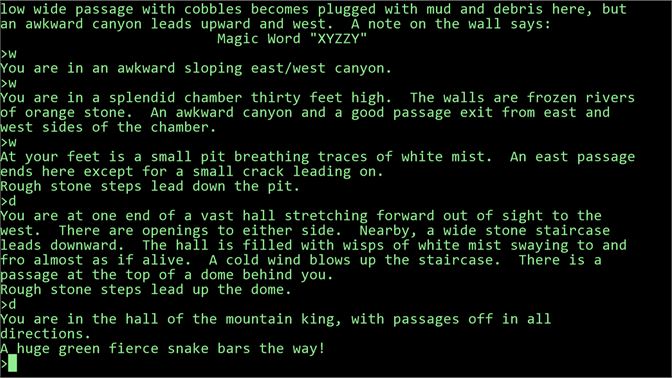
It is worth making a small digression and noting that the everyday task of getting from point A to point B (from home to work, for example) does not necessarily require a detailed idea of the terrain in which the movement takes place. If we are talking about a well-known area, where we know the relative position of all the buildings, then we can draw a route based on our existing image of this area. However, for typical, regularly used routes, we use not an image of the terrain, but an automated program of actions based on landmarks: get to the traffic lights, cross the road, reach the end of the street, etc. About the same thing we do when we need to navigate in an unfamiliar area, but we don’t have a map at hand: we catch an aborigine, call him a final destination, and he draws up a program of actions for us with landmarks.The goal is achieved - we get where we need to - and at the same time we save our mental efforts, without spending them on building an integrated image of space and route in this space. A real need for an image of space arises when the program crashes: for example, we get to the next checkpoint and find that everything has been dug up there and it is impossible to go through. At this point, we recall the image of the area and wonder what possible workarounds.At this point, we recall the image of the area and wonder what possible workarounds.At this point, we recall the image of the area and wonder what possible workarounds.
Accordingly, for different people the image of the surroundings of their home can vary greatly in detail depending on their needs and preferences. Those who like to walk a lot know every building in the district and can go to any other from anywhere in the area, since they have in their heads a detailed image of the entire area. And homebodies can have literally several trodden routes, outside of which the terrain is terra incognita for them. And this will not necessarily be associated with a deficit of visuospatial function: here also the motivation factor is included. In order for a person to have an image of a locality, one needs not only the ability to build it, but also the motivation that will support the activity of surveying the locality - that is, the contraction of the surroundings with their legs up and down. On the other hand, the engine of development is experience,and if there is no experience with orienteering, then the ability to orientate will not develop. If a convinced homebody still needs to master a new area, then we can expect that, all other things being equal, he will spend more time on it than a lover of walks, since he will solve an unusual task for himself.
One track, two track
A related cartography genre of board games are games in which tiles are laid out on the field in such a way as to make a card. This, in particular, Carcassonne and the Little Prince. The basic task that a player in Carcassonne solves is in essence very similar to a game with a Sorter or SEGEN board. Only here it is no longer the shape of the hole that varies, but the additional conditions on the sides. For example, in this zone you can put a tile only under the condition that it will have a road on the right and also a road below:
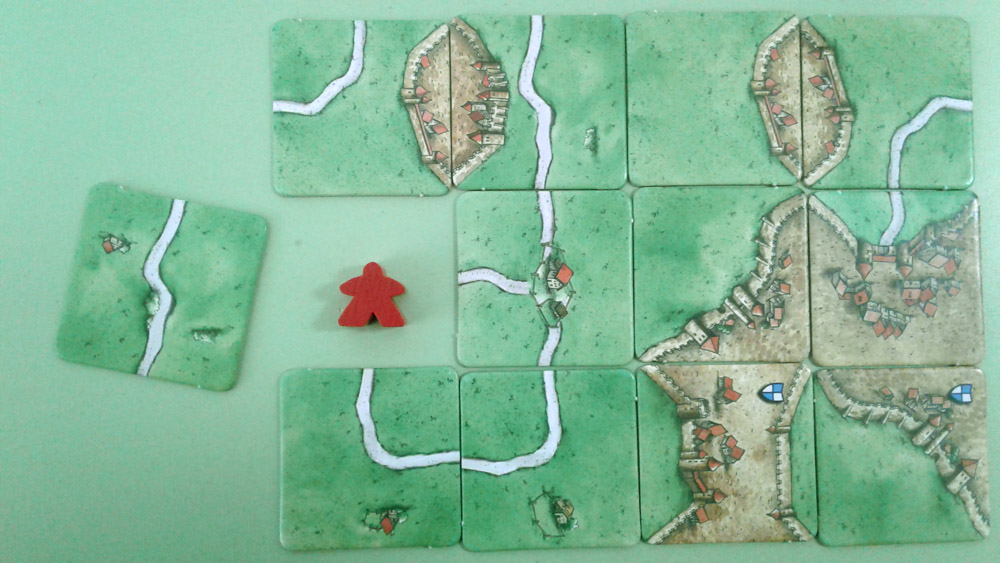
Here a logical analysis can be added to the mental rotation of the picture: if my tile has opposite and not adjacent edges to the road, then I won’t be able to put it here, no matter how you turn it. For children, such an analysis becomes available for about six to seven years. In general, in Carcassonne with children, you can start playing with five. At this time, the only rule that we give the child is that the roads should coincide with the roads, cities with cities, and fields with fields. After the child has successfully mastered this rule, you can add the mechanics of capturing cities and roads, as well as teach the child to count points.
A typical mistake made by preschoolers is when they set a tile in a field bordering two or three other tiles, but check if the edges match for only one neighboring tile:
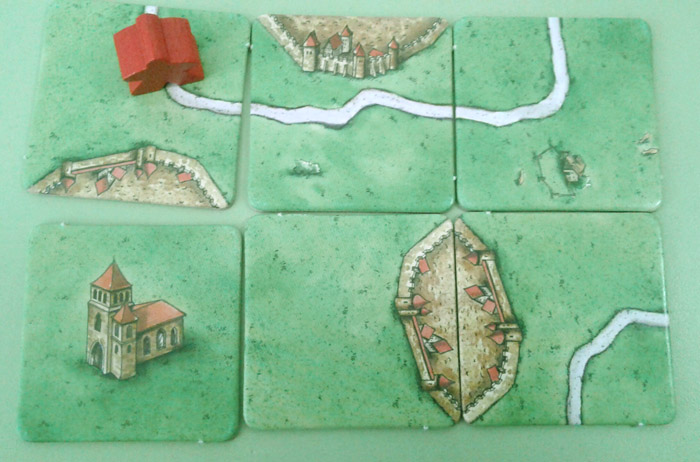
This error is usually not directly related to the visual-spatial function, but rather is associated with the immaturity of the frontal functions: voluntary attention, programming, and activity control. If a child often makes mistakes of this type, it can be fairly confidently assumed that in the classroom he makes many mistakes by negligence (and does not correct them himself if not asked), and the two- and three-step instructions cause him difficulties. At the age of five, such errors are expected (for this we play in order to learn to control our actions), and at the age of six a large number of them should be alarming.
The Little Prince is a game for older children, this is about the primary school age. And not so much because there is a complex system of scoring, but because the tiles should result in a circle, and it is very difficult for preschoolers to use circle segments. At six or seven years old, you can try to play it, but before the eyes of children there should be a clue depicting how different parts of the field are combined into one round planet. Based on the sample, some preschoolers already have this task (but not all).
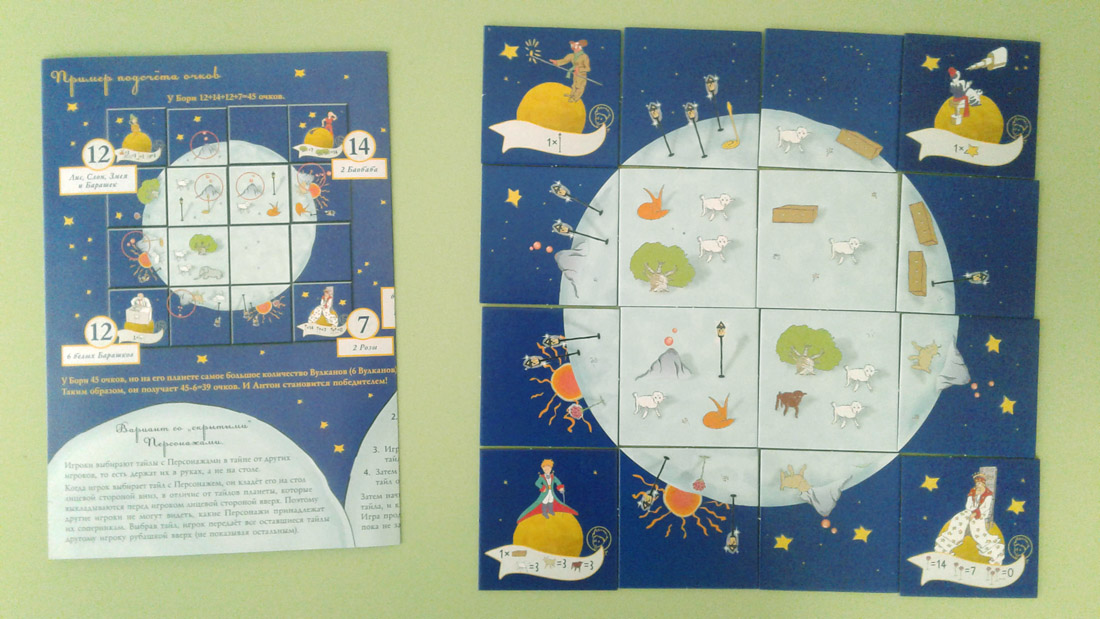
Tantrix is a game with Carcassonne’s related mechanics (color tracks should only dock with tracks of the same color), but the field here is no longer in a cage, but hexagonal, which sensibly increases the level of complexity. And we must also keep in mind that Tantrix is a much more abstract game than Carcassonne, and very few children at the age of six are interested in solving purely logical problems. Therefore, if we decide to play Tantrix with preschoolers, then it would be nice to come up with a plot for it: for example, that these are wires in a computer, or secret paths along which spies move.

Trucks is a seemingly simpler game, but in fact, it will not work for a child earlier than primary school age: precisely because Trucks is even more abstract and figuratively inexpressive than Tantrix. This is a pretty niche game: like other abstract logic games, it will be attractive mainly for young mathematics lovers.

Tetrisoids
A wonderful tool for the development of visual-spatial function, and at the same time logical thinking, are games, the details of which are elements of pentamino, tetramino or trimino (in different combinations). The main ambush here is that it is precisely those children who find these games most useful that are least likely to play them. The mental efforts that are required are burdensome and unpleasant for them. And here the task arises of balancing unpleasant mental work with something that is attractive to the child: either an interesting plot, or a successful design, or better both of them at the same time.
The simplest task for visual-effective and visual-figurative thinking that can be offered on components of this type is a more or less arbitrary filling of the field with figures (you cannot go beyond the borders, but you can leave holes in one cell). Such mechanics are in the games Patchwork and Leaf Fall. In full, these games are designed for primary school age, but you can use them as a puzzle (let's make a rug of bright autumn leaves) since the age of five. Small errors in fitting tiles do not play a role here, because holes can be filled with single chips, so a child can practice spinning pieces of this type (including mental), without experiencing irritation due to the fact that this does not work out well.

Patchwork and Listopad have a different color - Patchwork is calm, and Listopad is bright, saturated. If the child does not have any particular preference on the topic (I die, as I like patchwork quilts), then Listopad will be more suitable for exhausted, inactive children, since it will be sensory tonic at the same time, and Patchwork excitable and noisy, since it is easier for such children to concentrate when the colors are calm.
The next task is the exact filling of a given sample figure with a small amount of details, and we can indicate them to the child in advance, or suggest that he choose the most suitable ones (depending on his success). For example, the Japanese puzzle "My Neighbor Totoro." Here the lowest level of difficulty is when an adult collects all the details except two in a frame, and the child needs to put the remaining ones in the empty seat. When the two details are already obtained, the adult leaves the child three details, and so on. Such puzzles can be used from five to six years (depending on the capabilities of the child).
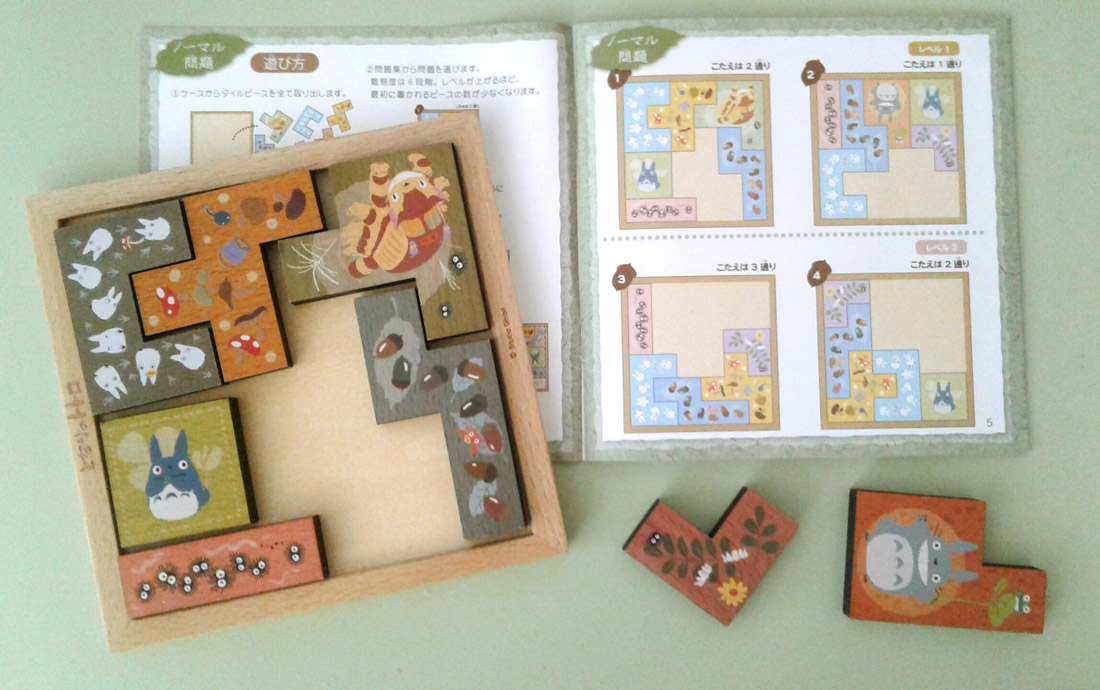
In Ubongo, you need to fill in the tiles with a sample on the task card. Here the minimum number of tiles is three; in addition, an element of stress is added, due to the fact that the game is competitive and for a while. With six-year-olds you can play Ubong, but not for very long - they quickly get tired of it, because you have to think a lot and hard. The game becomes fully available at primary school age. Ubongo is great for exhausting children - it has bright colors, an interesting design and a component of “precious stones” that is invariably attractive to children. But it is better to play with exhausted children without an hourglass to allow them to act at a pace that is comfortable for them.

The mechanics of a tetrisoid can be complicated by adding elements of the "track" type to the tiles that do not repeat the shape of the tile, and therefore they need to be joined independently. This is, for example, the Trubirint. In the Trubirint, two tasks need to be solved simultaneously: to extend the pipe from point A to point B and at the same time lay tiles with pipe parts so that they do not go beyond the boundaries of the permitted part of the field and do not overlap each other. Some children can cope with this at the age of six, but in the general case, the game becomes available as early as primary school age.
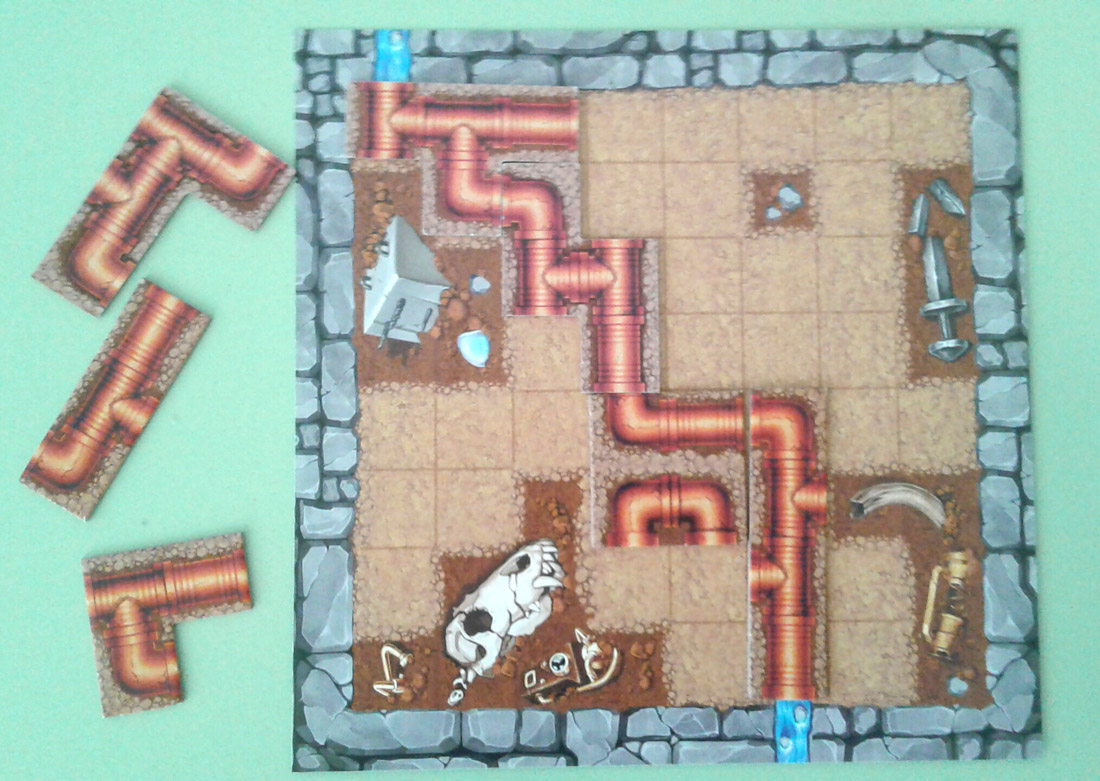
In addition to their shape and the tracks depicted on them, the tiles of the KlokBlok puzzle have other parameters that can be used to add complexity: the "weight" of the tile, its color group, and the number of cells it occupies. A game with many options is more suitable for teenagers.

Tetrisoid games are very good as family games, because age does not give them a significant advantage. The purposeful development of visual-effective and visual-figurative thinking occurs mainly at the preschool educational level and partly in elementary school, and then the main emphasis is on the development of verbal-logical thinking and the accumulation of factual knowledge. Thus, by the age of seven to eight, the child’s abilities in solving puzzles of this type do not differ very much from the capabilities of, for example, his mother. The child may even be ahead of her, because at training sessions in the kindergarten and school, he periodically has to solve similar problems, but his mother does not have the same training. Accordingly, all participants in the game can play at full strength, without making discounts on each other's capabilities - and for all this will be useful.
A three-dimensional puzzle related to tetrisoids is cubes of catfish (in the materials of the Nikitins - “Cubes for all”). Here the elements no longer consist of squares, but of cubes, and the task is to make up a certain spatial structure from several elements. Cubes of catfish are available from the age of six, but children do not perceive them as a toy, but rather as a teaching aid and, as a rule, do not play them on their own initiative (too difficult). A child of primary school age with cubes of catfish will cope easier, but he will most likely prefer other, more attractive objects to them. So this toy is more likely for a specialist office or class than for a home.

Tangram and his relatives
Another group of puzzles that contribute to the development of visuospatial function is tangram type puzzles: sets of geometric figures that add up to one large figure, or into a picture on assignment. The same principle applies here as with tetrisoids. In its pure form, such puzzles are mainly interesting for those children who are doing well with thinking and operating with visual objects. And those children who have difficulties have to be lured into solving such puzzles: either with the plot of the assignment, or with a nice design, or better, both. Therefore, if we choose such a game as a developing one, first of all we need to pay attention to how good its design is.
For example, a series of such puzzles made in Japan:

The colors are quite rich, with an unobtrusive ornament on the elements. Material - cardboard. Such a performance is suitable for a student who is already interested in solving puzzles. For a preschooler, the elements are not strong enough, but for a disinterested child they are visually too monotonous. Camping option with magnetic parts, oriented to the same category of children:
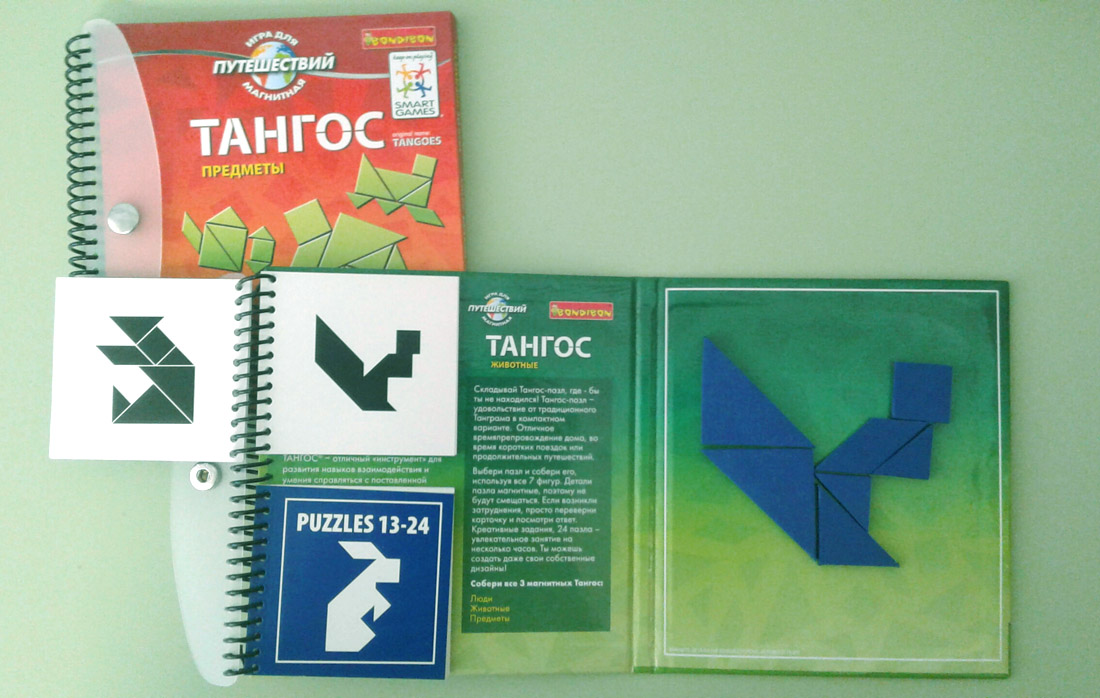
But for comparison, a couple of options for the classic tangram, suitable for working with preschoolers:
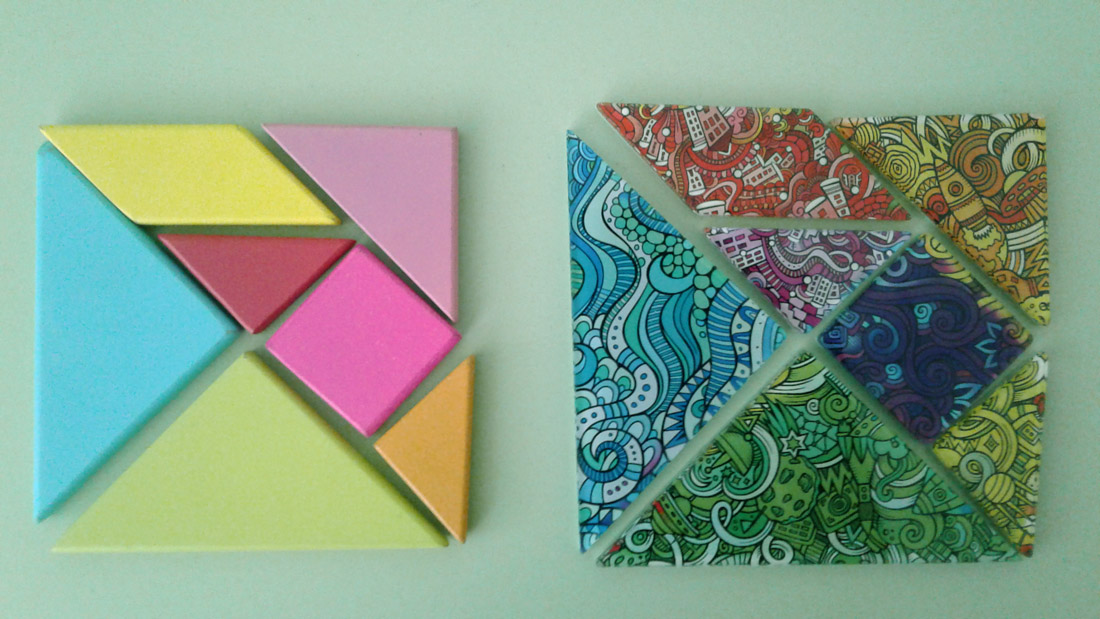
On the left is an unnamed Chinese product of the “cheap and cheerful” type, the material is wood. On the right is the tangram from the Happy Alphabet, plexiglass. Both options are anti-vandal enough to survive the direct hit of a not very neat preschooler. The first is more suitable for carrying out formal tasks (nothing distracting), and the second for free play: it has very nice ornaments that the child will be interested to consider and which can become the starting point for the plot.
At the age of five, puzzles are available for children with elements, mainly in the form of squares and triangles, rectilinear. This is exactly the same tangram, and also composite squares from Nikitin materials. Curvilinear elements are more complex: at six, you can add sectors of the circle, closer to seven - more complex curves. Here, for example, is the tangram-heart and the ellogram of Evgeny Tikhonov (designs of the Happy Alphabet):

As for the tasks, it is convenient when the tasks on the cards are given in full size of the details so that they can be solved by the overlay method. This is important for preschoolers and for those schoolchildren who have difficulty solving such problems. You can start with tasks where two or three elements are used, and these elements can even be selected in advance for the child. If the child copes successfully, then the number of elements in the task can be increased. For some children, turning the part to the desired position itself can be difficult, and you can play tangram with them, giving a sample with the already defined boundaries between the elements, so that the child makes up the picture by overlaying.
What does it mean?
Oddly enough, speech also partly works on the functions of handling spatial relationships. The fact that a child who does not navigate in space may have problems with mathematics is intuitively clear, but he can also have difficulties with mastering his native speech. In particular, this applies to prepositions. If the child does not understand the nature of spatial relationships, which are indicated by prepositions, then he will often confuse them. And quasi-spatial language constructions (“in my imagination”, “along with this phenomenon”, “torn between two desires”) are very difficult to understand if the corresponding spatial categories are not learned.
Accordingly, another type of didactic games on the theme of space is the execution of tasks for understanding prepositions. Thus, in principle, you can play with any toys that are at hand, but especially for this are good sets of small toys designed to balance. This is such a specifically Asian type of toys, in Japan they are called tsum-tsum. Their direct purpose is to make tall, balanced structures triumphing over the force of gravity. But you can use them in another way. Take, for example, a box of junk from the cartoon “Delivery Service Kiki” and ask the child: “Put the loaf in the bag, put the white kitten on the bag, and put the mug in front of the bag.” Thus, in one fell swoop, we train fine motor skills, auditory attention, auditory memory, understanding prepositions, and executing a three-step instruction (that is, a programming and activity control function). And the child enjoys fussing with cute things.

When to watch out
The games described above, in any case, are useful for supporting the development of the child, but for some children they will be much more needed than others. We may suspect that the child has difficulty with visuospatial function if we note the following:
- The child has difficulty orienting in familiar spaces. In a kindergarten, after a few months of visiting, she does not remember where to turn to get into her group. He does not remember how to get to the playground (for verification, ask the child himself to remind you today where to go).
- If something doesn’t creep into the hole during the game, or if the designer’s parts do not connect, he applies force, but does not try to turn the toys relative to each other.
- The child’s drawings are noticeably different from the drawings of his peers: they are more primitive, resemble scribbles, it is difficult to distinguish the form in them. Moreover, the child followed the same program as the others, and he did not have long absenteeism.
- Starting to master the letter, often makes mistakes such as "mirroring". Mirrors individual letters or generally writes from right to left, and not from left to right. He cannot answer the question correctly, where is the right side and where is the left.
If something worries you, it is advisable to consult with a neuropsychologist as soon as possible about the features of the development of the child, because the sooner we find a problem, the faster and more efficiently it can be solved. Best of all, if the difficulties can be detected before entering school, and not at the moment when they have already become the cause of school failure. If it becomes clear that in the garden the child is somewhat behind peers, then this is a signal that the development of the child needs support. It is very important that he receive this support on time.